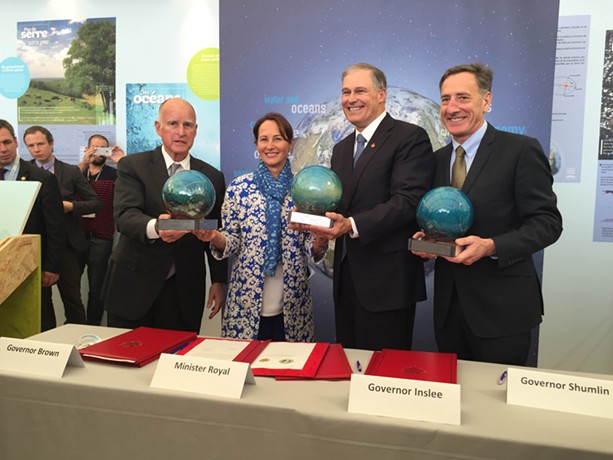Tuesday, December 8, 2015
Paris, Day 8: States step up to the climate challenge
Posted By Lauren Kastner on Tue, Dec 8, 2015 at 1:30 PM
Nuvo reporter Lauren Kastner is in Paris for the historic climate change talks and is sending daily dispatches. CITY is running a selection of them.
While all eyes are on commitments that nations are making to address climate change at the high-stakes talks in Paris, cities and sub-national groups globally are also leading where countries have fallen short.
In Paris on Monday, United States Governors Jerry Brown of California, Jay Inslee of Washington, and Peter Shumlin of Vermont signed a memorandum of understanding with the French Embassy to the United States committing to state climate leadership.
Individual states cannot independently decide foreign policy, yet their influence in shaping the narrative at home in the US and here in Paris is critical to building ambition for delivering a strong climate deal. Once a climate deal is reached here in Paris, the US Department of State has to bring it home and sell it to the American people. With local and state leaders such as the governors here this week, that task will be much easier.
“There is hope coming from the states,” Shumlin said in his remarks. “We are joining the race against the clock which we all know is ticking more loudly each day. States are making a difference despite Congress to not only use less resources but to collaborate with our neighbors to get it right.”
Earlier this year, the US pledged to cut greenhouse gas emissions 26-28 percent below 2005 levels by 2025. As I’ve written before, it will take every current domestic environmental regulation to go through as planned to meet this target. This includes emissions reductions through the Clean Power Plan for coal-fired power generation, standards for heavy-duty engines and vehicles, energy efficiency standards, and a whole lot of other things the federal government has yet to roll out. How states choose to meet these targets will be essential to upholding the US's commitments in a climate deal.
Meeting these emissions targets will not be without challenges, but as Brown noted, there are tremendous opportunities for states who choose to get out in front of climate change and lead.
“We’re sailing into adverse winds and some folks from the business community say we can’t do what we’re doing,” Brown said. “In California, we know that regulation inspires innovation.”
The signing ceremony with these governors was more goodwill than anything, but it should make residents of other states take notice.
While all eyes are on commitments that nations are making to address climate change at the high-stakes talks in Paris, cities and sub-national groups globally are also leading where countries have fallen short.
In Paris on Monday, United States Governors Jerry Brown of California, Jay Inslee of Washington, and Peter Shumlin of Vermont signed a memorandum of understanding with the French Embassy to the United States committing to state climate leadership.
Individual states cannot independently decide foreign policy, yet their influence in shaping the narrative at home in the US and here in Paris is critical to building ambition for delivering a strong climate deal. Once a climate deal is reached here in Paris, the US Department of State has to bring it home and sell it to the American people. With local and state leaders such as the governors here this week, that task will be much easier.
“There is hope coming from the states,” Shumlin said in his remarks. “We are joining the race against the clock which we all know is ticking more loudly each day. States are making a difference despite Congress to not only use less resources but to collaborate with our neighbors to get it right.”
Earlier this year, the US pledged to cut greenhouse gas emissions 26-28 percent below 2005 levels by 2025. As I’ve written before, it will take every current domestic environmental regulation to go through as planned to meet this target. This includes emissions reductions through the Clean Power Plan for coal-fired power generation, standards for heavy-duty engines and vehicles, energy efficiency standards, and a whole lot of other things the federal government has yet to roll out. How states choose to meet these targets will be essential to upholding the US's commitments in a climate deal.
Meeting these emissions targets will not be without challenges, but as Brown noted, there are tremendous opportunities for states who choose to get out in front of climate change and lead.
“We’re sailing into adverse winds and some folks from the business community say we can’t do what we’re doing,” Brown said. “In California, we know that regulation inspires innovation.”
The signing ceremony with these governors was more goodwill than anything, but it should make residents of other states take notice.
Latest in News Blog
More by Lauren Kastner
-

Dispatches from Paris: Day 5
Dec 4, 2015 -

Dispatches from Paris
Dec 1, 2015 - More »


